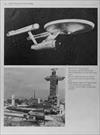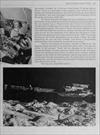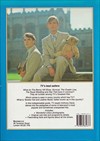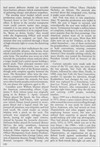Criticism
Book Critics
(David Kyle, 1976, Hamlyn) p151
Space 1999 is again, for the SF buff, inferior, with an unbelievable plot. It should be oh so much better than Star Trek because there isn't just a starship making the trip, it's Earth's entire Moon accidentally zooming around uncharted space discovering new planets, aliens and other unpredictable adventures. The old mistake of forgetting that it takes SF knowledge to write SF stories results in abysmally bad stories for Space 1999.
(Ed Brian Ash, Pan 1977)
Science Fiction on Television: United Kingdom (p303)
Anderson's talents were later put to better use in Space 1999, a series with all the faults bequeathed it by those who call the genre 'sci-fi', but strong on special effects. Set on the Moon, which has been blasted out of orbit and is wandering through space, it has contained much questionable science but has also shown some story potential.
(Jeff Rovin, A.S.Barnes and Co. 1977)
Chapter 10, Television (p162)
"UFO" gave the production team of Gerry and Sylvia Anderson an adult vehicle for the miniature work they had perfected with such
children's shows as "Captain Scarlet" and "Thunderbirds." Ultimately, this effort led to television's most expensive science. fiction show, and also one of its worst, "Space: 1999". This continuing saga of our rootless, inhabited moon's journey through the
universe costs nearly $700,000 per episode and looks it: the sets, costumes, and model work are magnificent. The rest of the program is considerably less than magnificent. For, despite its technical polish, "Space 1999" is scientifically inept and dramatically shallow. It is not nearly as entertaining as "The Six Million Dollar Man" and his sister heroine "The Bionic Woman." These two characters are cyborgs, half-human, half-robot, With preternatural powers. Quite ingeniously, to portray absolute control over their bodies, all extraordinary deeds performed by the stars are done so with the camera running at high speeds. This gives bulk to the wood, canvas, and hydrocal boulders they are forever tossing around, and slows down the players to infuse their every move with import. Thus, with these video comic books and "Space 1999," television has brought us full-circle. We began our study of special effects with George Melies and his naive but technically impressive films; we conclude with naive but technically
impressive television programs. The question that thus becomes obvious is where does the art of movie special effects go from here?
Les Brown, 1977 p406
SPACE;1999- syndicated hour long sci-fi series produced in England by ATV (1975-) and distributed in the US by its subsidiary, ITC. Produced on a large budget, part of which was justified by its showing on Britain's independent network, Space unabashedly sought to cash in on the Star Trek rage. Its cast was headed by American actors Martin Landau and Barbara Bain, a husband-wife team that had gained notice in Mission: Impossible. Rejected by the American networks, the show found a receptive market among individual stations, many of which were network affiliates. Space made a strong threat in syndication early in the fall of 1975, but the ratings soon flagged. Organic changes were made in the second year to improve its chances.
The changes included the addition of Catherine Schell to the cast and the hiring of Fred Freiberger, who had been associated with Star Trek, as producer. The second skein involved more action and greater use of special effects.
by John Brosnan (Macdonald & Jane's, 1978) p503; (Appendix: SF on TV)
1975: SPACE: 1999
(UK)ITC. Gerry and Sylvia Anderson unleashed this absurd 'sf' series on American and British audiences in 1975. An explosion of radioactive waste sends the Moon hurtling into deep space, taking with it a large lunar base & its inhabitants. Before long they enter other solar systems (the moon appears to be travelling at the speed of light) and encounter alien worlds, just as the characters in Star Trek had done. The cast included Martin Landau, Barbara Bain, Barry Morse, Nick Tate and Catherine Schell. The first season was produced by Sylvia Anderson and the second by Fred Freiberger, who had previously produced The Wild,Wild West and the third and final season of Star Trek. The special effects by Brian Johnson were the most outstanding feature in a series which ended in 1976.
Consultant editor Robert Holdstock (Octopus;Cathay 1978)
Chapter on "Screen Trips" by Alan Frank: p85
Not surprisingly, Star Trek spawned imitators, the most considerable of which has been Space: 1999, made in Britain but with American leads, Martin Landau and Barbara Bain, to give it appeal for the American networks. The series' premise was that Moonbase Alpha, under the command of Landau's Captain Koenig, is doomed to wander the universe after the Moon itself was torn out of Earth orbit because of a massive explosion of nuclear wastes dumped on the satellite. Once in space, however, the adventures of the 300 or so reluctant passengers of the wayward satellite soon turn out to be a poor imitation of the format of Star Trek. The series' failure was due to two main factors. The first was that the scripts themselves were banal and their science fiction content was soon subordinated to mediocre adventure themes. The second, and potentially more damaging factor was that the leading characters were dull and uninteresting, falling back on stock stereotypes and emotional cliches so that they never became alive in any sense or were able to transcend their material. Even the inclusion later in the series of a female alien, able to metamorphose into other life forms, never succeeded in being anything other than a not very good plot gimmick.
Alan Frank (Octopus 1978) (p16)
In Britain, an attempt was made' to create a series that would duplicate the runaway success of Star Trek. The result, Space 1999, which debuted in 1975, failed to repeat history. In America and Britain it was not networked in a regular slot, which spelled death to the series. In many ways the format was too close to that of Star Trek. Instead of a space vessel cruising the universe, Space 1999 featured a similarly hermetically enclosed community adrift in the cosmos, only this time living on a portion of the moon blasted from the surface of the satellite into independent orbit. None of the regular characters, unlike the quirky but credible crew of Star Trek's spaceship Enterprise, managed to be anything more than conventional ciphers, the plots were mostly uninteresting and unconvincing, and only the series' production design and its special effects, directed at Bray Studios by Brian Johnson, who had worked on 2001: A Space Odyssey, impressed, particularly the meticulous miniatures and lunar landscapes.
by Suares and Siegel (Reed Books, 1979) (Text by David Owen) p24:
The most technically accomplished of all sci-fi TV shows was the short-lived Space 1999, whose Moonbase Alpha set was a genuine achievement.
by Harry Harrison and Malcolm Edwards (Orbis, 1979) p125
Photo caption: Space 1999, a TV series with some interesting spaceship designs, but no other redeeming features.
Of course television budgets are not as limitless as those of the screen, so the model work leaves a certain amount to be desired. No one minded this in Thunderbirds and Fireball XL-5 when the models were actually seen as models, strings and all, and flown by eye-bulging puppets. The team of Gerry and Sylvia Anderson did very well with these two series for children and they still look good upon re-run. But the weakness of the effects and the paucity of the plot became apparent when they produced Space 1999. The strings holding up the model spaceships are no longer visible: the ones supporting the plot are very evident. This series is purportedly science fiction, but is noted for its scientific inaccuracy.


(Ed Peter Nicholls, Granada 1979) (p559)
SPACE 1999 (John Brosnan) This British made series, created by the Andersons, was obviously inspired in part by the success of Star Trek. Here, too, the format involves a group of people travelling through the galaxy, visiting different planets and encountering strange life forms. But where the Star Trek characters travelled on a spaceship, the Space 1999 characters do their interplanetary wandering on Earth's runaway moon - an unwieldy gimmick that must have caused many frustrations to the writers. Despite excellent special effects and imaginative sets the series as a whole was strangely lifeless and bland, a fault that seems to beset most Anderson productions. The characters were stereotyped and the scripts humourless. The other major flaw with the series was a disregard for basic science which many critics saw as scandalous: stars are confused with asteroids, the Moon's progress through space follows no physical laws and parsecs are assumed to be a unit of velocity.
Stars are not confused with asteroids. Possibly this is an inaccurate impression of the opening of the episode Black Sun, where an asteroid is torn apart, and then the Alphans discover the black sun (black hole). The asteroid was moved off course by the black hole, it did not turn into the black hole.
The Moon's progress through space follows standard Newtonian physics, but does not take into account the vastness of distances in space.
Parsecs are mentioned in two episodes, The Taybor and Space Warp, and in both are units of distance.
TELEVISION (John Brosnan; p577) In 1975 Gerry Anderson, after the failure of UFO, created a pale imitation of Star Trek with his series Space 1999. Surprisingly, it enjoyed some success in America, but only briefly, and it ended after two seasons. The series represents a nadir in the quality of scientific thought in televised sf.
Also mentioned in entries on 'Scientific Errors' (p532, Peter Nicholls & John Sladek) "Space 1999 was a particularly bad offender" and 'Parsec' (p451, by Peter Nicholls). "We're travelling at 17 parsecs?" the hero of the TV series Space 1999 might erroneously cry."
edited by Peter Nicholls (Michael Joseph 1982)
Chapter "Where science fiction gets it wrong" by David Langford. p197
Television still gives plenty of amusement to bad-science fans. In recent years the worst offender by far was the series Space 1999 (1975), in which parsecs are used as a unit of velocity instead of a unit of distance; stars are confused with asteroids, sound travels in vacuum; there is daylight between the stars; and an explosion sends our Moon (undamaged) careering through space at faster than the speed of light.
'Formerly Halliwell's Teleguide' 2nd Ed, 1982 p586; 3rd Ed 1986 p769
SPACE;1999 GB 1975-6 48x50m colour
ATV/Gerry Anderson
A space station breaks away, travels through the universe and encounters alien civilizations. Star Trek in all but name; an ambitious and sometimes imaginative production, handicapped by lack of pace and humour and two very doleful leads.
Martin Landau, Barbara Bain, Barry Morse, Catherine Schell
Edited by Dick Fiddy (Virgin 1985)
Chapter "Archive" by Neil Alsop p129
Viewing the alien environments of Fireball XL5, the origin of the sophisticated imagery of the live action Space: 1999 is quite apparent. Those lucky enough to have had further opportunities to see more episodes from the second series of Space: 1999 of late will have appreciated the similarities despite the differences brought about by over a decade of technological advances in special effects. Imaginative storytelling combined with visual excellence created in the first series of Space 1999 not only Anderson's crowning achievement but also what has turned out to be the apogee of science fiction on the small screen. Regrettably, although it became a cult series overseas, as far as the ITV companies were concerned it was a ratings flop, so when that second series came along it was an item principally for export. Eight years on, there are still some British viewers who have not had a chance to see all the second series episodes, whilst others have enjoyed two or three screenings of each story (some featuring guest performances by Pamela Stephenson, Sarah Douglas and Lynne Frederick early in their careers).
by the Editors of Video Times Magazine (Signet,USA, 1985) p21
DESTINATION MOONBASE ALPHA (1975) C Dir:Gerry Anderson. With: Martin Landau, Barbara Bain, Catherine Schell. (2 stars on a scale of 1 to 4)
A feature version of the Australian- made teleseries Space: 1999 consisting of two edited episodes. Landau is the commander of a space station called to investigate a planet invading the Earth's solar system, but first he must contend with a mysterious illness which is killing off his crew. Landau and Bain (then husband and wife) have a compelling chemistry on screen, but the same cannot be said for the abrasive clashing of the disco music score and the sterile futuristic atmosphere."'
edited by David Wingrove (Longman 1985) p24
ALIEN ATTACK (1977). Feature-length adaptation of several episodes from the British TV series Space: 1999, wherein the build-up of 'magnetic radiation' in a Nuclear Waste dumping site on the moon results in an explosion which fires the moon (and Moon-Base Alpha with 300-plus staff) out from Earth's orbit, and off on a journey towards the distant stars. The first half of the film deals with this, the second with an encounter with a wandering planet, Meta, a veritable Utopia of perfect harmony. Man meets and is dismissed by superior beings as being "a contaminating organism", not yet fit for Utopia. The special effects are as good as anything Star Trek ever offered, though there's less glamour and more pseudo-science in this space-opera, set-unlike the series-in 2100.
Plot .2 stars; Technical Skill 5 stars; Entertainment 5 stars; Artistic Merit: 1 star. (scale 1 - 5 stars)
by John Javna (St Martin's Press 1985) p226
This British space-adventure series only lasted a few years. and it was syndicated (rather than appearing as part of a network schedule), so many people have never even heard of it. S-f fans, however, know it well. For its time (1975-76), it featured the best special effects ever televised. And it starred two TV stalwarts with a cult following of their own - Martin Landau and Barbara Bain. The story: It was a typical day on Luna when - kablooey! - the nuclear waste dump on the far side exploded, propelling the moon away from the Earth forever. With it went moonbase Alpha and its 311 residents, including Commander John Kcenig (Martin Landau) and Dr. Helena Russell (Barbara Bain). Apparently travelling at a considerable rate of speed, they reached solar systems in a matter of days, encountering some of the most mystical life-forms this side of 2001: A Space Odyssey. One even signed onto the crew - Maya, who could transform herself into any living creature in the universe (and was the only woman ever to look lovely in sideburns). The show was released with a great deal of fanfare, but space-adventure doesn't seem to fare well in prime time; production ceased in 1976. You can still see it in some cities, and if you love space fantasy, it's worth checking out.

by Anthony Davis (Boxtree, in association with Independent Television Books, 1988) p120-121
Space 1999 was a British-made Star Trek in 1975, about a space station driven out of orbit around the moon and travelling through the universe. It was made by Gerry and Sylvia Anderson, who had moved on from Thunderbirds and other puppet series to employing human actors, but who still utilised their expertise at special effects, model-making and table top photography. They had already made one science fiction series, UFO, in 1970, which was set in the near future - the 1980s - with a cast that included Ed Bishop as commander of SHADO (Supreme Headquarters, Alien Defence Organisation), an organisation set up to defend Earth against unidentified flying objects, with interceptor craft crewed by girls in flesh-tinted; skin-tight cat suits and mauve wigs, controlled from a base on the moon.
Space 1999 was set in 1999 when man was using the dark side of the moon as a dump for nuclear waste. The waste exploded, tearing the moon apart and hurling Moonbase Alpha, which had been monitoring the dumping, out of orbit and into space with 300 people on board. The stars were the craft's Commander Koenig (Martin Landau), and two of his officers, Prof. Victor Bergman (Barry Morse) and Dr Helena Russell (Barbara Bain). Joan Collins also appeared - in silver, green and mauve eye shadow - as Kara, Director of Reconstruction on the ship. The crew wore unisex garments with different coloured sleeves to indicate their departments.
Some of their experiences were closely akin to those of Star Trek's officers. One episode featured a planet where all feelings were reversed, the inhabitants laughing when in pain and crying when happy. Another planet had Arctic wastes (made from solidified fire extinguisher foam) where Ice Maidens inappropriately favoured revealing cleavage.
After the first year Gerry and Sylvia Anderson split up matrimonially and professionally, and Anderson brought in Fred Freiberger who had produced the third season of Star Trek. New characters included an alien, Maya (Catherine Schell), a sort of female Spock, capable of transforming herself into any form of organic matter - such as a tree, a gorilla or a lion. (A cage was built for the camera crew, so that animals could roam the set.) A co-production with the Italian television organisation, RAI, Space 1999 was dubbed into Italian, French and German, and although it was not even fully networked on ITV in Britain, Sir Lew Grade managed to sell it around the world.



by John Clute (Dorling Kindersley, UK, 1995); p301 Thanks Chris Moore
The Andersons' second venture into live-action SF was visually splendid but flopped owing to mediocre acting and, most of all, rotten scripts. The Moon, including a manned base, is blasted out of Earth's orbit by a nuclear accident. Cruising through the galaxy, the colonists meet and kill implacably hostile aliens.
by Paul Cornell, Martin Day and Keith Topping (2nd edition, Guinness, UK, 1996); p333
Anderson returned to telefantasy (and the Moon) with Space: 1999, which, due to Anderson's wish to sell the series to the American market, starred Martin Landau, Barbara Bain and Barry Morse and cost more than all his other series put together. The premise was excellent, the Moon being blown out of Earth's orbit by a nuclear explosion. Unfortunately, despite a promising beginning, a clutch of guest stars including Anthony Valentine, Brian Blessed, Joan Collins, Peter Cushing, Christopher Lee and Leo McKern, and several well-remembered episodes - such as the extremely weird 'Black Sun' and the horrific 'Dragon' Domain' - the series was vacuous, slow-moving hippie drivel. A second season, made in 1976, tried to be a more standard adventure, and, in doing so, found new ways to be awful.
General editor David Pringle (Colour Library Direct [Carlton Books], UK, 1997); p146
Using models rescued from the wreckage of the series UFO, Gerry and Sylvia Anderson attempted an imitation of Star Trek which succeeded in running for two seasons (48 episodes) despite labouring under the terrible handicap of using the moon (or at least a fragment thereof) as an improbably fast moving space vehicle. The scripts collaborated with this absurd device in setting new standards of scientific illiteracy, and the ultra cheap special effects led British fans to dub it 'Space Nineteen Pounds and Ninepence', but success in the US kept the show going.
[This is probably the only review to ever accuse the special effects of being cheap!]
Although Landau, Bain and Morse were all competent actors who had done good work on other shows, Space: 1999's scripts gave them no chance to conjure up credible performances and, at times, they seemed hilariously incompetent as they soldiered on bravely against the odds. The combination of atrocities was almost bad enough to qualify the show as a kitsch classic, but its real achievement was to make Star Trek seem sophisticated by comparison.
(The series profile was alongside a sidebar on "kitsch classics", which pronounced the show too bad to be kitsch. One photo - a Year 2 publicity shot of Maya in burning Eagle- was captioned: Aaargh! All writers of TV SF need to master this useful item of dialogue; more as can be [sic] added if necessary.)
by Daniel O'Brien (Reynolds and Hearn, UK, 2000); p104-107
The potential is there, yet neither executive producer Anderson nor his creative team ever gave the material a real sense of style or purpose, perhaps a reflection of the show's hasty, stop-gap conception. ...The ersatz Kubrick approach just doesn't work, no matter how much the directors cut to lingering soft focus close-ups of Barbara Bain. The crew of Moonbase Alpha is made up of bland, ill defined characters whose blank faced interaction creates little sense of warmth or even professional camaraderie. ...The scripts tend to offer a promising initial situation, sometimes quite intriguing, but rarely develop ideas into strong storylines. Occasionally, by some mysterious cosmic alchemy, the show got something right, notably with the episode Dragon's Lair. ...This is efficient, effective horror.
by Chris Taylor (Head of Zeus, US, 2014); p148
ILM's artists were proud of their spaceship models, but there was already a major problem with one of them. Local stations across the United States had started screening Space: 1999, a science fiction TV show imported from the UK, in late 1975. It was set on the moon, which is knocked out of orbit and into interstellar space by a nuclear explosion. Space: 1999 had been aimed at the US market, with American actors and a hefty $3 million special effects budget for the first season. It was bad enough that the characters mentioned a "mysterious force" that was supposedly guiding the moon's journey or talked about the problems of "going to the dark side" (of the moon). Worse that the moonbase's major ship, the Eagle, looked a lot like Han Solo's long, sleek pirate vessel, which ILM model makers had just completed, and which Lucas had just named in the fourth draft: the Millennium Falcon. Eagle, Falcon: Lucas was going to look like a plagiarist.
So ILM had to come up with a bold and costly new design. The original Falcon had cost $25,000 - a third of the whole model budget. It was reused as the rebel ship at the beginning of the movie, the Tantive IV.
The Space: 1999 SFX was a lot less than $3 million, which was half the total budget of the show. There are various mysterious forces in different episodes, not necessarily benevolent. No-one talks about "going to the dark side". The book does not mention that George Lucas visited Brian Johnson at the Space 1999 SFX stages and asked him to work on Star Wars (he couldn't for the first film, but he worked on the sequel, The Empire Strikes Back).
Contents copyright original authors; this compilation copyright Martin Willey